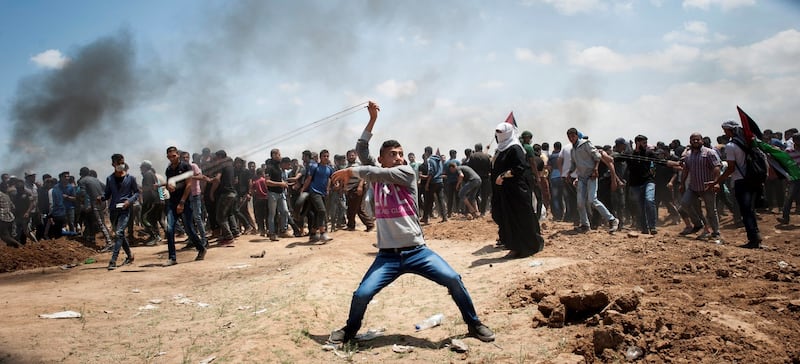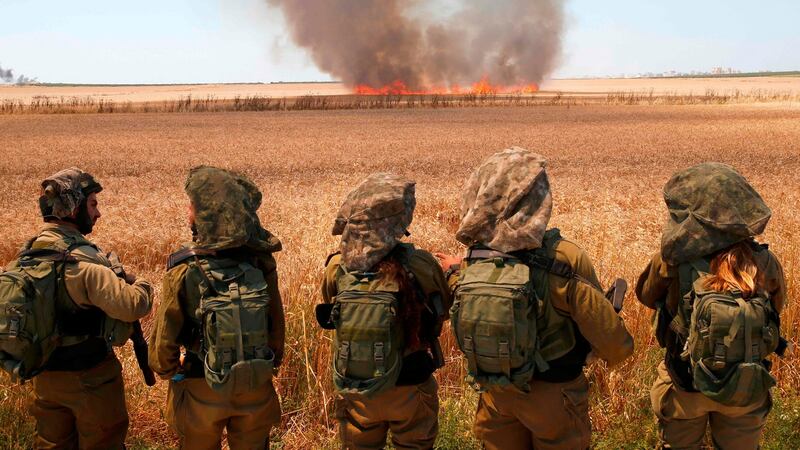Daniel Rahamim (63) had four Palestinians from nearby Gaza at his wedding in 1983. He remembers sunbathing on Gaza's beaches, and drinking tea at a friend's antiques shop there. But that was long ago – before Hamas, and the wars that traumatised his children, and the security barrier that now fences off the Gaza Strip like an open-air prison.
On Monday, as gunfire echoed across the wheat, sunflower and jojoba fields stretching several hundred yards to the fence, Rahamim felt conflicting emotions. “When we hear of the dead, it pains us,” he said the next afternoon. “I hope at least that each bullet was justified.”
From the agricultural hamlets with their backs up against Gaza to the busy sidewalks of Tel Aviv and Jerusalem, and all the way to Israel's northern borderlands, Israelis grappled in different ways with the staggering casualty reports from the Gaza protest on Monday: 60 killed, more than 1,700 hospitalised, according to Palestinian officials. It was the worst one-day total since the 2014 Gaza war. Israel said that only a small number of those shot had been armed.

That fundamental imbalance – heavily armed soldiers firing on mostly unarmed demonstrators, or rioters and terrorists, as the military termed them – elicited responses of defiance or defensiveness in some, shame in others, and a healthy dose of served-them-right in some corners. Others only wanted to celebrate the new US embassy, which was dedicated in Jerusalem as shots were ringing out in Gaza.
At Tel-Hai College in the Upper Galilee, after Arab students held a moment of silence for the Gaza victims, the mayor of nearby Kiryat Shmona, Nissim Malka, publicly called for their expulsion, saying the school must not be allowed to be turned into another Bir Zeit University – a Palestinian institution on the West Bank.
The short-story and screenwriter Etgar Keret, who clicked compulsively on a news site watching in horror as the death toll climbed, said he was taken aback by the responses of his Tel Aviv neighbours when he observed, simply, “What a day.”
Some enthusiastically agreed, assuming he meant the new US embassy, he said. Others nodded, expressing pride in Israel’s winner of the Eurovision Song Contest. “I was sure every person I’d meet would have a comment on Gaza, but most of them wanted to talk about Ivanka’s dress,” Keret said. “I couldn’t help thinking it was some kind of suppression. Because, what can you say?”
It was the lack of empathy he had discerned in some of his neighbours that got to him. “You feel like saying, ‘Think about the hundreds of Israeli soldiers having to shoot unarmed people and kill and maim them,’” he said. “They could be your children or your siblings. They’ll come home on Saturday, and I’m betting they won’t come back the same.”
Consoling consciences
In Tuesday's Israeli newspapers, some columnists seemed to want to console readers whose consciences may have been stricken by the bloodshed. Ben-Dror Yemini, a columnist for Yediot Ahronot, searched for a culprit and landed upon what he called the "Nakba culture", which he said had held back Palestinians going back to 1948.
"There was a Nakba," he wrote in Tuesday's paper, using the Arabic term for the "catastrophe" of the formation of Israel and the loss of Palestinians' homes. "The Arabs of Palestine underwent expulsion. Tens of millions of people throughout the entire world, including Jews, underwent similar expulsion. But only the Palestinians adopted an ethos of rejectionism, victimhood, suffering and death."
Few mainstream Israelis questioned the motives or professionalism of the soldiers charged with protecting the Gaza fence and nearby communities, with deadly force if necessary. Eran Lerman, a former deputy national security adviser who now helps run a conservative think tank in Jerusalem, said no Israelis believed that their army was callous about the loss of life. "The only possible conclusion is they were left with very little choice," he said.

He said he had come to believe that the casualty numbers were “actually quite low” compared with what he called the nightmare scenario: “A few hundred Palestinians dashing in the direction of a kibbutz or a military position in hopes of grabbing some soldiers, killing some and dragging others into Gaza.”
“The only alternative would have been, in that case, to mow them down one and all,” he said. “So this has to be measured not against some ideal of a nonlethal solution, but against Hamas’s purposes and what would have happened if they had breached the fence.”
Army claims
The army provided new details Tuesday about Monday’s confrontation to bolster its contention that the Gaza demonstration was no innocent protest but what commanders called a “terrorist operation” orchestrated by Hamas. Eight of the dead, the army said, were armed Hamas militants in civilian clothes who tried to storm the fence in northern Gaza and attacked Israeli forces with grenades and pipe bombs before being killed in a shoot-out.
A photograph showed what the military said was an Israeli battalion commander’s armoured vehicle pockmarked with Kalashnikov fire. Another three militants were killed while laying an explosive device in the south, the army said.
Rebutting accusations that the military used excessive force, two senior officers of the Maglan commando force said the armed Hamas force in the north emerged from the crowds and attacked a patrol vehicle and five of their positions, including those of snipers perched on sand berms along the fence.
They said they killed four militants in the first contact, then another four arrived in a jeep. As soon as the militants opened fire, they said, the civilian protesters fled the area. The episode ended after a 20-minute exchange of fire.
The officers, whom the army insisted could not be identified, rejected the outcry from critics, saying that each day of protests they had witnessed attacks on the fence and military infrastructure, and that Hamas had exploited the civilian protesters in order to try to break through.
“It’s very different when you see it with your own eyes,” one officer said, “when you feel the threat.”
Happier times
In Nahal Oz, an eerie calm prevailed Tuesday. Schools were open as usual, and people went to work. Residents recalled both the happier times when Gazans would come to work on the kibbutz, and the tough battles along what has often been a hostile frontier. Some lamented the Israeli government’s dismissal of exploring a long term cease-fire with Hamas.
"We and the citizens of Gaza are neighbours, though we no longer have neighbourly relations," said Yael Raz Lachyani (41), a mother of three who was born in Nahal Oz. "I have very mixed feelings. We don't want to live by our swords, but we do expect our army to protect us."
“After yesterday,” she added, “it’s a very tough feeling to know that defending me and my children meant hurting others. But they – and their leaders – put themselves in an impossible position. We have to defend ourselves.” – New York Times









